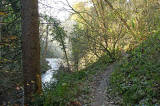|
Around Edinburgh Roslin [Rosslyn or Roslyn on old maps and pictures] About seven miles to the south of the centre of Edinburgh |
|
ENGRAVINGS FROM 'MODERN ATHENS' |
POST CARD |
|
POST CARD |
POST CARD |
|
CARTE DE VISITE BY JOHN MOFFAT |
|
|
More photos Roslin Glen |
|
Rosslyn History |
|
|
Rosslyn Chapel Rosslyn Chapel, with its many religious and other carvings, stands on the edge of the Esk Valley, above Rosslyn Glen, about seven miles to the south-east of Edinburgh. It was built in 1446 by William St Clair, third and last Prince of Orkney and has been a place of pilgrimage over the centuries. [The Rosslyn Association] |
|
|
Around Rosslyn Also in the area is: - Rosslyn Castle, visited by Robert Burns, 13 June 1786
- Hawthornden, visited by Queen Victoria Prince Albert, 14 Sept 1842. [Rosslyn Exhibition at National Galleries of Scotland, ended July 02] |
|
Rosslyn Chapel Painters and Photographers |
|
Dioramas Louis-Jacques-Mandré Daguerre, before announcing his discovery of the Daguerreotype photographic process, in Paris in 1839, produced dioramas. These were huge pictures, painted on transparent linen, which gave a spectacular effect when lit by combinations of light from in front and behind. One of his subjects, exhibited in Paris in 1824, was Rosslyn Chapel. The diorama (22 meters x 14 meters) has not survived, but an oil painting of the chapel by Daguerre (approx 1 sq. metre) still exists, and was exhibited at The National Galleries of Scotland in July 2002. The chapel, both the exterior, and the interior with its elaborately carved Apprentice Pillar has been a popular subject for photographers an artists. Here are a few. |
|
Photographs The chapel was photographed by: - Hill & Adamson, 1802-70, 1821-48, calotypists 1843-47 - Roger Fenton 1819-1869, photographs 1856 - George Washington Wilson 1823-1893, photographs c.1880 - William Donaldson Clark 1816-1873, photographs c.1880 |
|
Paintings Rosslyn Chapel was painted by: - David Roberts 1796-1864, watercolours 1820s-1840s and oil 1843 - John Clerk of Eldin 1728-1812 drawings or paintings for engravings - Samuel Dukinfield Swarbreck, drawings or paintings for engravings - Hugh 'Grecian' Williams 1773-1829, painting 1795 - John Thomson of Duddingston 1778-1840, amateur painter - Julius Caesar Ibbertson, paintings c.1800 - Alexander Nasmyth 1758-1840 oil paintings, 1780s- 1800 - James Nasmyth Son of Alexander oil paintings. [Rosslyn Exhibition at National Galleries of Scotland, ended July 02] |







